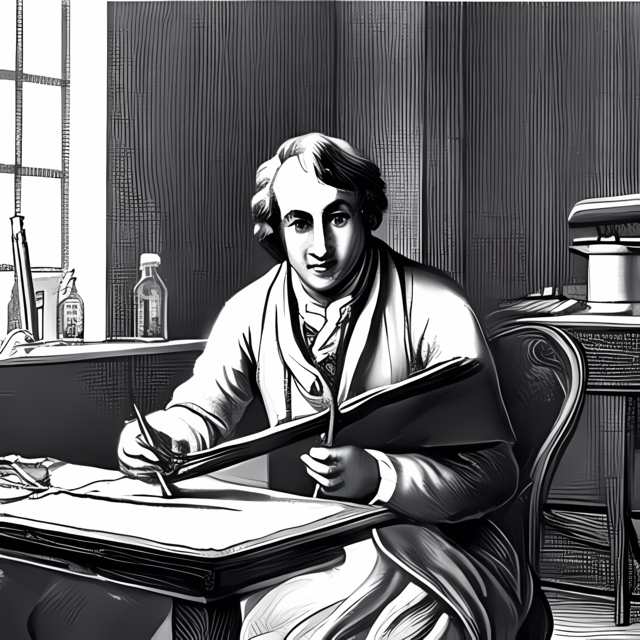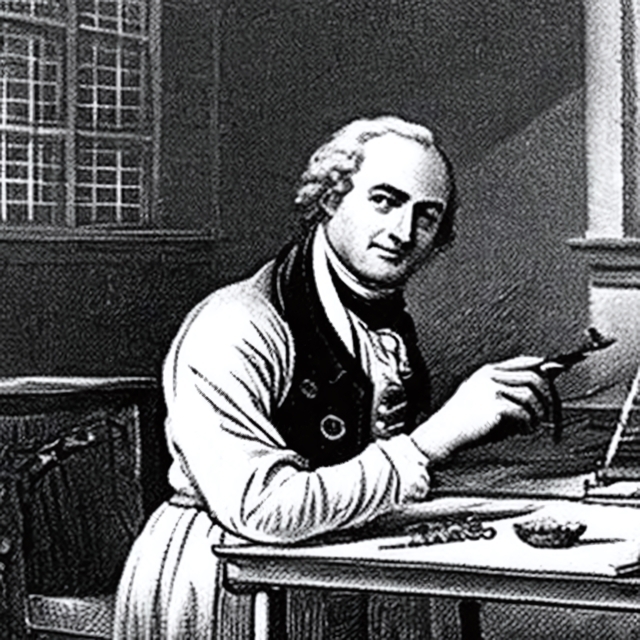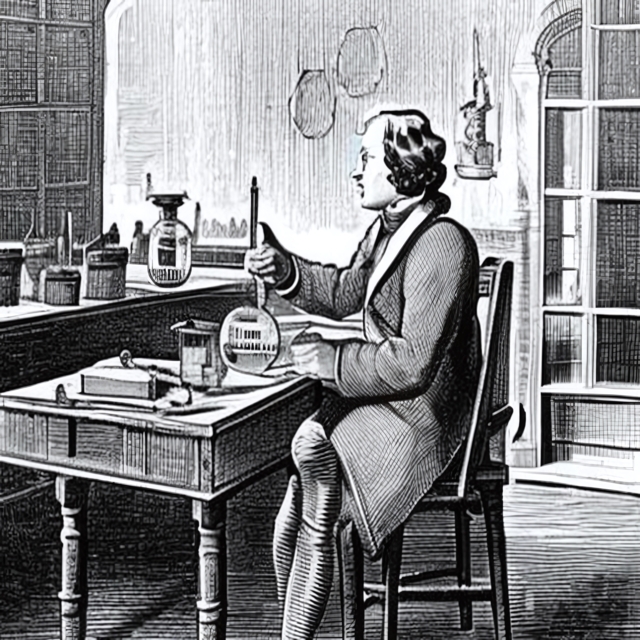Water is one of the most common and essential substances on Earth. It covers about 71% of the planet’s surface and makes up about 60% of the human body. It is also vital for many biological and chemical processes, such as photosynthesis, respiration, metabolism and solvation. But what is water made of? How did we discover its chemical composition? And who was the first to prove it experimentally?
The answer to these questions lies in the work of a remarkable scientist named Henry Cavendish (1731-1810), who was one of the most influential chemists and physicists of the 18th century. Cavendish was a prolific scientific investigator, performing experiments on not only water but also electricity, magnetism, gases, heat and gravity. He was also extremely wealthy, but lived a secluded and eccentric life, avoiding social contact and fame. He published only a few of his discoveries, and many of his papers remained unpublished until long after his death.
One of his most important papers was titled “Experiments on Air”, which he presented to the Royal Society in 1784 and published in 1785. In this paper, he reported his experiments on the synthesis and analysis of water by burning hydrogen in oxygen. He showed that water was a compound of these two gases, and that they combined in a fixed proportion by weight. He also measured the density and specific gravity of water and its constituent gases with great accuracy.
Cavendish’s paper on water was a landmark in chemistry, as it established the law of definite proportions and the concept of chemical elements. It also sparked a controversy with another famous scientist, James Watt, who claimed to have discovered the composition of water independently. In this blog post, we will explore Cavendish’s paper in detail, including its historical context, experimental methods, results and implications. We will also discuss the controversy with Watt and its resolution.
Historical Context
Before Cavendish’s paper on water, there were several attempts to understand the nature and composition of water by various scientists. Some of them were:
– Robert Boyle (1627-1691), who performed experiments on the distillation and purification of water, and suggested that it might be a compound of two “principles” that could be separated by heat or electricity.
– Georg Ernst Stahl (1660-1734), who proposed the phlogiston theory, which stated that all combustible substances contained a common principle called phlogiston, which was released during burning. According to this theory, water was a compound of phlogiston and an “aqueous earth”.
– Joseph Black (1728-1799), who discovered carbon dioxide (which he called “fixed air”) by heating limestone and magnesium carbonate, and showed that it could be absorbed by water to form carbonic acid.
– Joseph Priestley (1733-1804), who discovered oxygen (which he called “dephlogisticated air”) by heating mercuric oxide or nitric oxide with a burning lens, and showed that it supported combustion and respiration better than ordinary air. He also discovered several other gases, such as nitrous oxide, ammonia and hydrogen sulfide.
– Antoine Lavoisier (1743-1794), who rejected the phlogiston theory and proposed that combustion was a reaction between a substance and oxygen. He also named oxygen and hydrogen (which he called “inflammable air”), and showed that they combined to form water when sparked in a closed vessel.
Cavendish was aware of these previous discoveries and built upon them in his own experiments. He had already isolated hydrogen in 1766 by reacting metals such as zinc or iron with acids, and described its properties in a paper titled “On Factitious Airs”. He had also studied the effects of electricity on various gases, such as carbon dioxide, nitrous oxide and hydrogen sulfide. He had also attempted to imitate the effects of the electric torpedo fish by passing electric sparks through water.
However, Cavendish was not satisfied with these experiments, as he wanted to determine the exact composition of water and its constituent gases. He also wanted to compare the weights of the gases before and after combustion, to test the law of conservation of mass proposed by Lavoisier. He devised a series of experiments to achieve these goals, which he described in his paper “Experiments on Air”.
Experimental Methods
Cavendish’s experiments on water involved two main steps: synthesis and analysis. In the synthesis step, he burned hydrogen in oxygen to produce water. In the analysis step, he decomposed water into hydrogen and oxygen by passing electric sparks through it. He used various apparatuses and instruments to perform these experiments, such as:
– A pneumatic trough, which was a large wooden tub filled with water, used to collect and store gases in glass vessels inverted over the water.
– A eudiometer, which was a graduated glass tube with a closed end and two platinum wires sealed through the glass, used to measure the volume and composition of gases by sparking them with electricity.
– A balance, which was a device with two pans suspended from a beam, used to measure the weight of objects by comparing them with known standards.
– A thermometer, which was a device with a glass tube filled with mercury or alcohol, used to measure the temperature of substances by the expansion or contraction of the liquid.
– A barometer, which was a device with a glass tube filled with mercury and inverted over a dish of mercury, used to measure the atmospheric pressure by the height of the mercury column.
Cavendish performed several trials of each experiment, varying the proportions and volumes of the gases, the duration and intensity of the sparks, and the temperature and pressure of the environment. He recorded his observations and measurements with great care and precision, and calculated the results using arithmetic and geometry. He also repeated some of his experiments using different metals or acids to produce hydrogen, or different substances to produce oxygen, to check for consistency and accuracy.
Results
Cavendish’s results from his experiments on water were remarkable and conclusive. He showed that:
– Water was a compound of hydrogen and oxygen, and not an element or a mixture of elements.
– Hydrogen and oxygen combined in a fixed proportion by weight of 1:8 to form water. This meant that 1 gram of hydrogen combined with 8 grams of oxygen to form 9 grams of water, or 1 ounce of hydrogen combined with 8 ounces of oxygen to form 9 ounces of water, and so on.
– The volume of water produced by burning hydrogen in oxygen was equal to the sum of the volumes of the gases before combustion. This meant that no gas was lost or gained during the reaction, and that the law of conservation of mass was valid.
– The density and specific gravity of water and its constituent gases were proportional to their weights. This meant that water was 9 times heavier than hydrogen, and oxygen was 8 times heavier than hydrogen, for equal volumes of each substance.
– The decomposition of water into hydrogen and oxygen by electric sparks required more energy than the synthesis of water by burning hydrogen in oxygen. This meant that water was more stable than its constituent gases, and that heat was released during the formation of water.
Cavendish also compared his results with those obtained by other scientists, such as Priestley, Lavoisier and Watt. He found that his results were consistent with theirs, except for some minor differences in the proportions or weights of the gases. He attributed these differences to experimental errors or variations in the purity or quality of the gases. He also acknowledged their contributions to the discovery of water’s composition but claimed priority for his own experiments.
Implications
Cavendish’s paper on water had profound implications for chemistry and science in general. It demonstrated that:
– Water was not an element, as previously thought by many philosophers and alchemists, but a compound that could be synthesized and analysed by chemical means.
– Hydrogen and oxygen were elements, as they could not be decomposed into simpler substances by any known method.
– The law of definite proportions was valid, as water always consisted of hydrogen and oxygen in a fixed ratio by weight.
– The law of conservation of mass was valid, as no matter was created or destroyed during chemical reactions.
– Chemistry was a quantitative science, as chemical phenomena could be measured and calculated using mathematical methods.
Cavendish’s paper on water also inspired further research on other compounds and elements, such as carbon dioxide, ammonia, nitric acid, sulfuric acid, chlorine, iodine and mercury. It also paved the way for the development of modern atomic theory by John Dalton (1766-1844), who proposed that matter was composed of indivisible atoms that combined in fixed proportions to form compounds.
Controversy
Cavendish’s paper on water was not without controversy. Shortly after its publication, James Watt (1736-1819), who was a famous inventor and engineer best known for his improvements to the steam engine, claimed that he had discovered the composition of water independently from Cavendish. Watt published a paper titled “Thoughts on Water” in 1784, in which he stated that water was composed of “dephlogisticated air” (oxygen) and “inflammable air” (hydrogen), and that they combined in a ratio of 1:7 by weight to form water. He also suggested that water was a “compound elastic fluid” that could be decomposed and recomposed by electricity.
Watt’s paper caused a dispute with Cavendish and his supporters, who accused Watt of plagiarism and dishonesty. They argued that Watt had learned of Cavendish’s experiments from Joseph Priestley, who was a friend of both Watt and Cavendish, and who had witnessed some of Cavendish’s trials. They also pointed out that Watt’s paper was vague and incomplete, and that he had not performed any experiments to verify his claims.
Watt defended himself by saying that he had conceived his ideas on water before he heard of Cavendish’s experiments, and that he had communicated them to Priestley in 1783. He also said that he had performed some experiments on water in 1782 but had not published them due to lack of time and resources. He admitted that his paper was imperfect but said that he had written it in haste to secure his priority.
The controversy lasted for several years, and involved many other scientists and philosophers, such as Benjamin Franklin, Thomas Jefferson, John Robison and Richard Kirwan. It was finally resolved in 1805, when the Royal Society appointed a committee to examine the evidence and decide the matter. The committee concluded that both Cavendish and Watt had independently discovered the composition of water, but that Cavendish had performed the experiments first and published them second, while Watt had performed the experiments second and published them first. The committee also praised both men for their contributions to science and recommended that they should share the credit for the discovery.
Conclusion
Henry Cavendish’s paper on water was one of the most important papers in the history of chemistry. It showed that water was a compound of hydrogen and oxygen, and that they combined in a fixed proportion by weight. It also confirmed the laws of definite proportions and conservation of mass, and demonstrated the power of quantitative methods in chemistry. It inspired further research on other compounds and elements, and paved the way for modern atomic theory.
Cavendish’s paper on water also sparked a controversy with James Watt, who claimed to have discovered the composition of water independently. The controversy was eventually resolved by the Royal Society, who recognized both men as co-discoverers of water’s composition.
Cavendish’s paper on water is a testament to his genius and diligence as a scientist. He performed his experiments with great care and precision, and reported his results with clarity and honesty. He also acknowledged the work of other scientists, but claimed priority for his own discoveries. He was a humble and modest man, who shunned fame and publicity, but left a lasting legacy for science.
References
– Cavendish H. Experiments on Air. Philos Trans R Soc Lond. 1785;75:372-384.
– West JB. Henry Cavendish (1731-1810): hydrogen, carbon dioxide, water, and weighing the world. Am J Physiol Lung Cell Mol Physiol. 2014;307(1):L1-L11.
– Maxwell JC (ed). The Scientific Papers of the Honourable Henry Cavendish F.R.S.. Cambridge: Cambridge University Press; 2015.
– Robinson J (ed). The Correspondence Relative to the Discovery of the Composition of Water: Between Mr James Watt F.R.S., Dr Priestley F.R.S., Dr Richard Kirwan F.R.S., Dr Blagden F.R.S., Mr Henry Cavendish F.R.S., Mr Lavoisier F.R.S., &c.. Edinburgh: Archibald Constable & Co.; 1805.
– Holmes FL. Henry Cavendish (1731-1810). In: Gillispie CC (ed). Dictionary of Scientific Biography. New York: Charles Scribner’s Sons; 1970: pp 131-141.
– Jungnickel C, McCormmach R. Cavendish: The Experimental Life. Lewisburg: Bucknell University Press; 1999.
– Wilson G (ed). The Life of the Honourable Henry Cavendish: Including Abstracts of His More Important Scientific Papers, And a Critical Inquiry Into the Claims of All the Alleged Discoverers of the Composition of Water. London: Printed for the Cavendish Society; 1851.
– The Scientific Papers of the Honourable Henry Cavendish, F. R. S. https://www.cambridge.org/core/books/scientific-papers-of-the-honourable-henry-cavendish-f-r-s/18AB7BB5D118605A1675E246B949B779
– Henry Cavendish (1731–1810): hydrogen, carbon dioxide, water, and …. https://journals.physiology.org/doi/full/10.1152/ajplung.00067.2014
– Henry Cavendish – Wikipedia. https://en.wikipedia.org/wiki/Henry_Cavendish
– Henry Cavendish – New World Encyclopedia. https://www.newworldencyclopedia.org/entry/Henry_Cavendish
– Henry Cavendish | Biography, Facts, & Experiments | Britannica. https://www.britannica.com/biography/Henry-Cavendish
Tags
Divi Meetup 2019, San Francisco
Related Articles
Unappreciated Greatness
Life and Legacy of Jahangir of the Mughal Empire. Jahangir ruled over one of the largest empires in human history during his lifetime, yet few people outside of South Asia have heard of him. I aim to shed light on the life and legacy of this remarkable figure,...
The Plague Doctor’s Diary
A Personal Account of the Turin Epidemic of 1656. I am writing this diary to record my experiences and observations as a plague doctor in Turin, the capital of the Duchy of Savoy, during the terrible epidemic that has afflicted this city and its surroundings since the...
The Timeless Beauty of Bustan
Unveiling the Secrets of Saadi Shirazi's Masterpiece.In the realm of Persian literature, few works have captured the essence of love, spirituality, and morality quite like Bustan (The Orchard) by Saadi Shirazi. This 13th-century masterpiece has left a lasting impact...
Stay Up to Date With The Latest News & Updates
Explore
Browse your topics of interest using our keyword list.
Join Our Newsletter
Sign-up to get an overview of our recent articles handpicked by our editors.
Follow Us
Follow our social media accounts to get instant notifications about our newly published articles.









